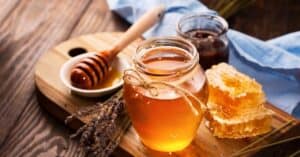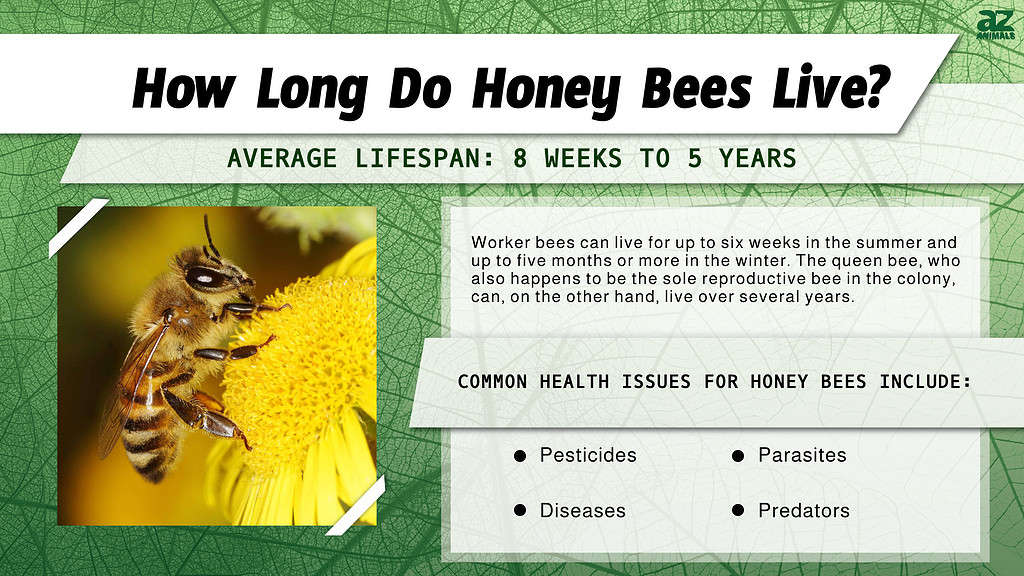
Traditionally, honey bees are known as hard workers who provide us with the sweetest gift – honey. In fact, the honey bee is the only insect that produces food that humans eat. We use both the wax and the honey that these bees generate for our own personal use. These tiny flying insects are absolutely fascinating to most of us, as we rely on them so much!
Do you want to learn more about these hardworking honey bees? We’ve got the scoop on honey bee lifespan plus a slew of other amazing facts you won’t want to miss!
The Rundown on Honey Bees
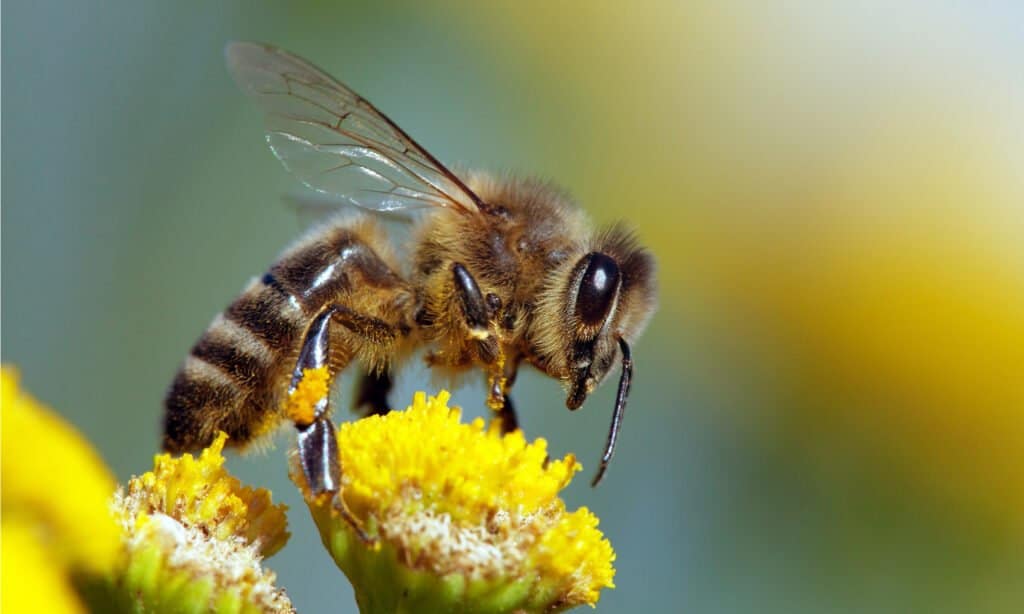
A honey bee can travel up to six miles and at speeds of up to 15 miles per hour.
©Daniel Prudek/Shutterstock.com
Apis mellifera is another name for the honey bee. Apis is an ancient term having Egyptian roots, but it is also linked to the Greek word for ‘swarm.’ Mellifera is a Latin word that means “honey-bearing.”
Honey bees pollinate flowers, fruits, and vegetables. This implies that they aid in the growth of other plants, which is why they are so important to the ecosystem. Bees carry pollen between male and female portions of plants, allowing them to produce seeds and fruit. There are around 2 billion honey bees around the globe, and you can find them almost everywhere besides Antarctica.
The honey produced by one honey bee during its lifetime is roughly a twelfth of a teaspoon. In one year, an entire bee colony may generate 80-100 lb (36-45 kg) of honey. This is why beekeeping has been such a popular agricultural practice around the world.
Now that we’ve learned more about them, let’s look at the honey bee lifespan.
How Long Do Honey Bees Live?
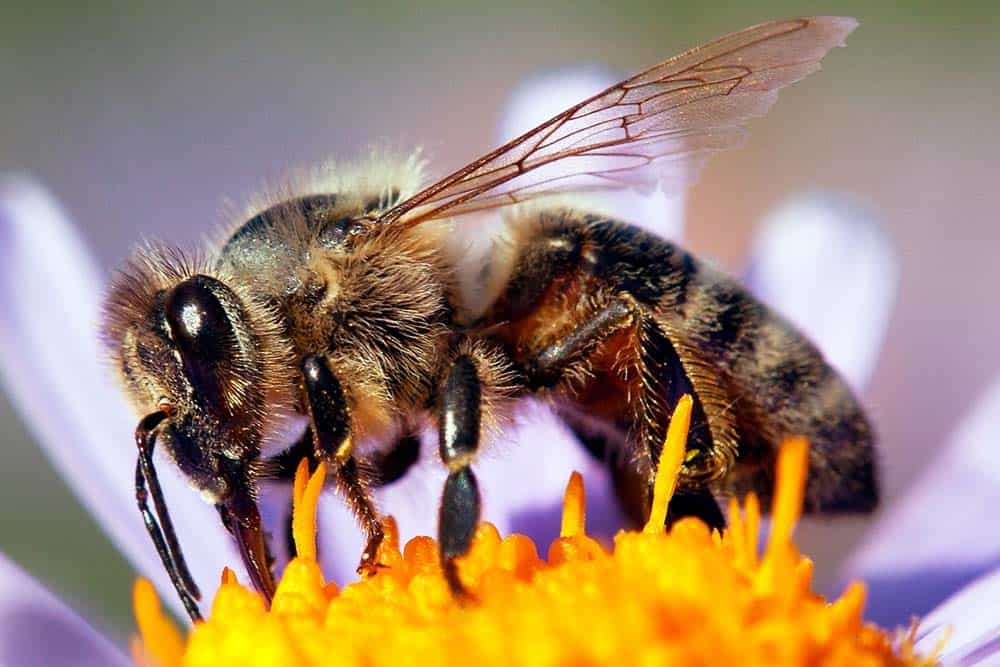
During her three to four-year lifespan, the queen bee may lay between 600-800, or even 1,500 eggs every day.
©Daniel Prudek/Shutterstock.com
The average lifespan of a honey bee is between eight weeks to five years, depending on the type of bee it is. Drone bees have a lifespan of around eight weeks. Worker bees can live for up to six weeks in the summer and up to five months or more in the winter. The queen bee, who also happens to be the sole reproductive bee in the colony, can, on the other hand, live over several years.
Although most subspecies’ queens survive three to five years on average, studies from the German honey bee subspecies (A. m. mellifera) historically used for beekeeping indicate that a queen can live up to eight years.
Because a queen’s sperm supply depletes at the end of her life, she starts laying more unfertilized eggs as she ages. This is why many beekeepers frequently change queens every year or two.
Let’s go further into the honey bee’s life cycle now that we have a better grasp of its average lifespan.
The Average Honey Bee Life Cycle
Honey bees have four unique life stages: egg, larva, pupa, and adult. The overall development period differs somewhat for the three bee castes but the process is ultimately the same.
Egg
The queen lays a single egg in each cell that has been cleaned and readied for a new brood by the worker bees. She walks on to the next cell if it is not clean enough for her. If she selects a regular worker-size cell, she releases a fertilized egg into it. That egg grows into a worker bee (female). However, if she selects a larger drone-size cell, the queen will lay an unfertilized egg. That egg hatches into a drone bee (male).
Larva
The egg develops into a larva three days after the queen lays it. Larvae in good health are pure white and resemble little grubs coiled up in their cells. The larvae are tiny at first, but they develop fast, shedding their skin five times. They are fed royal jelly by the nursing bees, and then they are weaned onto a honey and pollen combination. As the larvae begin to develop, the bees seal the cell with porous tan beeswax. The larvae spin a cocoon around their bodies after being trapped in to turn into a pupa.
Pupa
The larva has now developed into a pupa. The changes that are now taking place are concealed from view under the wax cappings. The pupae are developing into their adult forms behind the cappings. The eyes, legs, and wings all begin to take form. The eyes are the first to get some color, shifting to pink, purple, and then black. Finally, the tiny hairs that coat the body of the bee appear.
Adult
After 21 days, the mature bee eats her way through the wax capping to join the rest of the bees. As soon as the worker bee has moved away from the cell, it cleans up the cell and prepares it for the next egg.
Factors That Impact The Honey Bee’s Lifespan
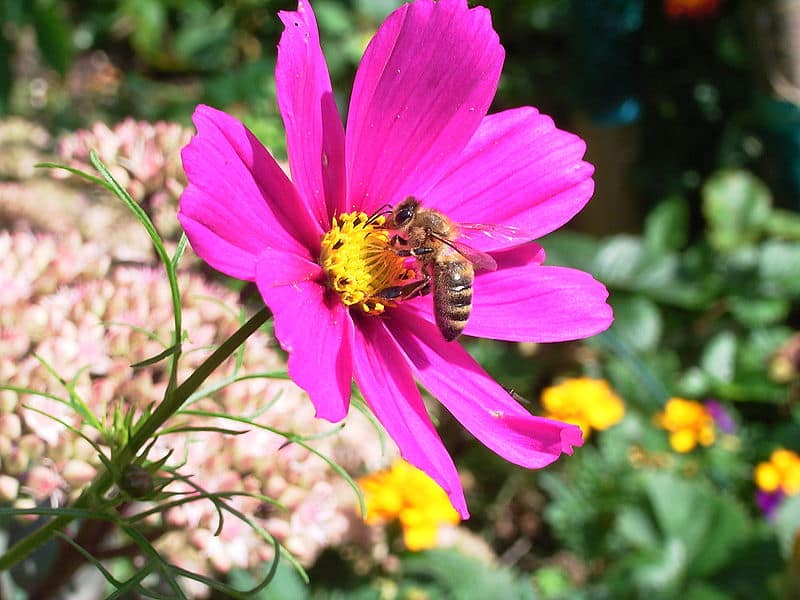
The lifespan of a honeybee can be influenced by predators like skunks and bears.
A honey bee’s lifespan can be influenced by a variety of circumstances. Bees usually die for natural reasons, but they can sometimes be eaten by other animals or murdered by other bees.
Some of the most common factors that impact the honey bee’s lifespan include:
- Pesticides: One of the most serious risks to honeybees is the extensive use of pesticides in industrial agriculture. According to one research, over two-thirds of beehives in Canada and the United States contain at least one synthetic pesticide. The most concerning is a kind of insecticide known as neonicotinoids, which have been shown to disrupt bee memory and navigation.
- Sickness: The most serious hazard to bees, though, is sickness or infection, which may wipe out whole colonies in severe circumstances. The parasite fly, Apocephalus Borealis, for example, compels bees to abandon the hive and die, and fly larvae arise from the deceased bees. This fly is also a carrier of the deformed-wing virus.
- Predators: Skunks, bears, and hive beetles are the most common attackers of honey bees. When skunks find a hive, they typically return every night to destroy it and eat dozens of bees.
The photo featured at the top of this post is © iStock.com/leekris
Thank you for reading! Have some feedback for us? Contact the AZ Animals editorial team.



